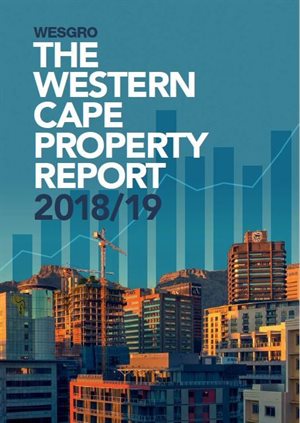Said Tim Harris, CEO of Wesgro: “This is a report that will enable both current and future investors to make the best possible decisions in terms of where to base their operations with the Western Cape, whether they are looking to set up a factory in an industrial area, opening a corporate office or even determining the most areas in which their staff can find homes.”
The report includes:
- Brief overviews of each municipal district featured in terms of the key economic sectors to be found within it as well as the avenues, agencies and incentives each one offers towards ease of investment.
- Property values for the 2018/19 financial year in respect of:
- Vacant land for sale (for commercial, retail and industrial development)
- Commercial property values for office buildings and retail venues in terms of sales and rentals being asked
- Industrial buildings for sale and to rent
- An overview of the residential property market with respect to market stock, price performance, age profile of owners, market activity in regard to units sold across a ten-year period (from 2008 to 2018), and the average asking prices during the period under review for residential rentals, from houses and townhouses to apartments.
- Data in the report has been drawn together from a variety of sources including, among others, the Western Cape Government Provincial Treasury’s Municipal Economic Review and outlook (MERO) 2018, the South African Property Owners Association (SAPOA)’s quarterly assessment of various commercial nodes, Lightstone Property’s overview of residential markets, and rental and sales values as they periodically appear on Property24.
“This is, however, the first time that all this data has been combined in one comprehensive report,” noted Harris. “It’s been a mammoth task that has taken the research team many months to compile and analyse, but it now provides a one-stop-shop guide to all property sectors in key nodes in the Western Cape.”
The markets within the towns of George, Saldanha Bay, Vredenburg and the Winelands towns of Stellenbosch, Franschhoek and Paarl are covered in full in the report. In terms of Cape Town, 21 suburbs were selected for analysis including in particular all the primary commercial, retail and industrial nodes.
Cross-section of Cape Town's entire marketplace
Said Carola Koblitz, the report’s editor and chief researcher: “We believe the Cape Town suburbs we’ve selected reveal an excellent cross-section of the Mother City’s entire marketplace, ranging from Atlantis and Somerset West, to the Cape Town CBD.
“In terms of residential, we looked at the primary nodes surrounding the chief commercial ‘centres’ and have included various suburbs in the Atlantic Seaboard, City Bowl, Southern Suburbs, Northern Suburbs and the Helderberg.”
A number of interesting factors have arisen as a result of the report, noted Koblitz: “For example, SAPOA’s research traditionally covers only seven key commercial areas in Cape Town and only in terms of office rentals and vacancies. These are Bellville, Cape Town’s traditional CBD, the Central (Pinelands) area, Century City, Claremont, the Rondebosch-Newlands area and the V&A Waterfront.
“While all of these nodes are included in the report, our research reveals just how strong the emergence of other areas is progressing across all property types, but particularly in terms of commercial development, whether these be properties for rent or for sale. For example, Somerset West, Woodstock and Salt River, and even areas previously only thought of as industrial areas such as Montague Gardens and Blackheath.”
Strong commercial markets
The report also emphasises the strong commercial markets that exist in towns such as Stellenbosch, Paarl and George. “There are office nodes in Stellenbosch that are now achieving higher rentals per square metre, at up to as much as R305/m2, than prime nodes within the City of Cape Town, such as the V&A Waterfront or Claremont, where top commercial rentals will fetch around R220/m2,” said Koblitz.
Acknowledging that property in the Western Cape had been under enormous strain in recent times, as it has across South Africa, and with much written in the financial press about the overheating of the marketplace particularly in certain Cape Town nodes, Harris said: “The bottom line in property is that it is always somebody’s market.
“While property in the Western Cape over the past few years has been extremely desirable, and prices rose quite steeply accordingly, recently we’ve begun to see a stabilisation – a normalisation, if you like. And that’s a good thing for investors right now, we believe.”
It is Wesgro’s intention to provide the report annually, continued Harris: “While the information contained in this edition is extremely valuable right now to investors, we believe its value will truly emerge over the next few years as we roll out further editions and provide a baseline over time by which to track the progress of the property market as it evolves within the province.
“Through this publication, we can now bring to the marketplace a definitive guide to the value of these locations.”
































